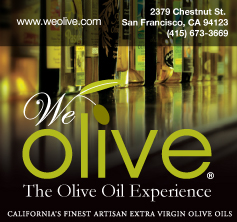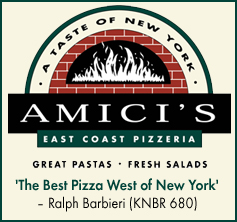 |

|
|||||||
|
DOSA goes green By Jim Maxwell The new DOSA on Fillmore restaurant (featured in “Newly Notable” February 2008) has transformed the former B of A and Goodwill building at 1700 Fillmore (at Post), into a shining example of green building and business practices. From its initial design concept in 2007, the emphasis for this new restaurant was to be as environmentally conscious as possible, from initial build-out to daily operation. In early 2008 I was fortunate to introduce our clients, owners Emily and Anjan Mitra, to environmental restaurant consultant Ritu Primlani of Thimmakka (www.thimmakka.org) to begin revamping the way the Mitras operated their first DOSA location on Valencia Street. Changing everything from the types of cleaners they used to the faucet heads on their sinks allowed the Mitras to create a more healthful environment for their staff and customers, as well as to conserve water and energy. It also served as a training ground for their staff and managers so the Mitras could bring these green business practices to their new restaurant on Fillmore. This greening of restaurants marks a real change in the mindset of restaurateurs, especially in an industry where the liberal use of water, electricity and toxic cleaning chemicals are standard operating procedure. As a restaurant designer for the past 19 years, I’ve long promoted green design, but with DOSA, I had a client who was willing to embrace green business practices to the fullest. Despite the added costs of many of the finish materials and mechanical systems, there is a significant upside – as Primlani likes to say, it is possible to “save the environment and save money.” At the new DOSA location, every piece of equipment was analyzed for energy efficiency and how it in turn affected the rest of the building systems. One such example is the refrigeration for all the coolers. Except for two small wine coolers, the refrigeration is handled by remote condensers on the roof, which remove added heat from within the building and reduce the cooling load by nearly 20 percent. The condensers in turn are controlled to cycle on less frequently during off-peak hours. Solar tinting on the enormous windows also reduces solar heat gain during the day and reduces heat loss at night, helping to maintain a more constant interior temperature. Ultra high efficiency heating and cooling units are equipped with a smart monitoring system so the multiple units work together to best control the interior environment. Another computer-operated Energy Management System (EMS) controls the speed of the exhaust fans for the kitchen, sensing the amount of heat generated under each hood and adjusting the fan speed accordingly. In a typical restaurant, the exhaust system works at 100 percent of its design capacity at all times, as if every burner, fryer, wok, grill, oven, etc., is turned on full blast. With the EMS, the exhaust and make-up air, (which must additionally be heated or cooled), is reduced to as low as 30 percent. DOSA also taps into the power of the sun with a solar water heating system that includes a 580-gallon preheat tank. Provisions have already been installed for a future solar power voltaic plant on the roof, once the owners have some revenue coming in to cover some of their initial investment. Because there are new technological advances being made in the field of solar power, chances are the new panels will be even more efficient than those currently on the market. Throughout the restaurant, water-saving devices were installed, including a waterless urinal in the men’s room, which alone saves thousands of gallons of water each year. While these additional measures meant additional costs driving up the project budget, each was evaluated as to how long it would take to recoup with the long-term savings. Attention was also paid to every detail of construction as well, from demolition of the old space – discarded materials were recycled – to materials used in the new construction. Metal framing was used wherever possible because it is recyclable and also uses less material. Where wood was used, it was FSC (Forest Stewardship Council) certified or sustainably harvested. Low- or no-VOC (Volatile Organic Compounds) finishes and adhesives were used throughout. Typically, commercial kitchens use FRP (fiberglass reinforced panels) on the walls, because it is cleanable and durable, but it is also a high-VOC material that is not only environmentally toxic when manufactured, but it continues to off-gas VOCs throughout its life and emits toxic gases when burned or buried. In this case, a no-VOC environmentally friendly epoxy paint was used to create a tile-like cleanable wall surface. While most of these environmental steps are behind the scenes, finish materials throughout were also specified because of their recycled or sustainable content: porcelain tiles (crushed quartz fused with water and heat only) and bamboo both provide long-lasting flooring solutions; the bar tops are made from recycled glass and mirrors; work surfaces are fabricated from recycled paper (yes, PaperStone!); FSC cherry hardwood was used as trim; and coconut palm fiber plywood (made with formaldehyde-free adhesives) was used to create cabinets and tabletops to complete the decor. Instead of the typical vinyl upholstery made with PVCs, “technology leathers” were selected for seating. Because of their PVC-free content and environmentally friendly manufacturing process, they are rated to last three times as long as similar vinyl fabrics, and are completely recyclable at the end of their lifespan. Even the booth and banquette frames were constructed of FSC-certified wood. Other upholsteries and wall-coverings were also specified because of their manufacturer’s commitment to earth-friendly manufacturing and business practices. And as the final touch, Benjamin Moore Aura paints were specified exclusively throughout the space for their low-VOC content (exceeding Greenguard standards), their rich and long-lasting colors, and their ability to allow touch up without changing the sheen – touch-ups are an ongoing process in a busy restaurant. (Benjamin Moore Paints are available at Fredericksen’s Paint on Fillmore.) While the Mitras are striving to be pioneers in the way South Indian cuisine is prepared and served, they are also looking to be leaders in San Francisco in terms of being green. They hope their example will be something that other neighbors – both residents and small business owners – will want to emulate, making the Northside a green center within the City. Jim Maxwell, owner of Architects II, designer/architect for Dosa Restaurant, and a principal in Full Plate Restaurant Consulting (www.fullplateconsulting.com), has lectured and conducted seminars on green restaurant design and planning. |
||||||||
 |
||||||||
|
||||||||
|
||||||||
|
||||||||



|
||||||||

|
||||||||


